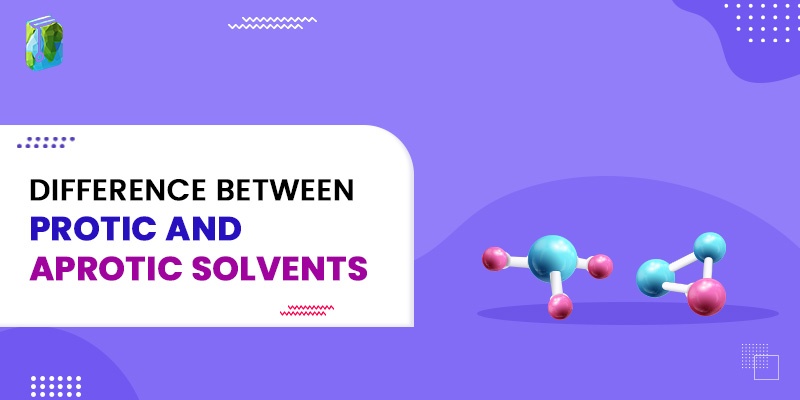If you are or have been a science student, you must know about solvents. If not, we are here to explain most easily.
Solvents are a heterogeneous group used to dilute or disperse other compounds. There are various kinds of solvents bifurcated into two groups, namely polar and non-polar solvents. The polar solvents are further categorized into two groups:
- Protic Solvents
- Aprotic Solvents
In this article, we will significantly elaborate on the meaning of these terms and understand them.
Let’s begin!
Difference Between Protic and Aprotic Solvents
Protic Solvents
A protic solvent consists of a hydrogen atom bound to an oxygen (hydroxyl group), fluoride, or nitrogen (amine group).
Protic solvents form hydrogen bonds as they have chemical bonds needed for hydrogen bonding, i.e., the N-H bond and the O-H bond. Hence, due to hydrogen bonding, both these groups, amine and hydroxyl groups (-OH), are vital components in protic solvents.
Protic solvents are acidic in nature as they release protons.
The dielectric constant of protic solvents is exceptionally high. You may ponder what is a dielectric constant?
Well, a dielectric constant is a property related to the polarizability of different materials. It refers to the proportion of a substance’s permittivity to the permittivity of free space.
Moreover, these solvents undergo SN1 reactions.
SN1 reactions are good for tertiary alkyl halide, as the loss of the leaving group leads to the formation of tertiary carbonation. Tertiary carbonation aced the list when it came to the stability of carbocations.
Here is a list of examples of protic solvents:
- Water
- Alcohols (methanol and ethanol)
- Hydrogen fluoride (HF)
- Ammonia (NH3)
Now, let us understand the meaning of Aprotic solvents!
Aprotic Solvents
Aprotic solvents do not possess hydrogen atoms that dissociate. These solvents do not form any O-H or N-H chemical bonds. Therefore, aprotic solvents lack the formation of hydroxyl and amine groups and aren’t able to form hydrogen bonds.
Additionally, aprotic solvents do possess ion dissolving power with all the protic solvents. These aprotic solvents do not have acidic hydrogen, therefore, there is zero dispersion of hydrogen ions. Whereas, polar aprotic solvents own a moderate polarity. The dielectric constant values are low or medium. These solvents undergo SN2 reactions. When compared to protic solvents, SN2 reactions are comparatively more rapid in polar aprotic solvents.
The examples for aprotic solvents are given below. Take a look:
- Dichloromethane (DCM)
- Ethyl acetate
- Tetrahydrofuran (THF)
- Acetone
Key Differences between Protic and Aprotic solvents
We have curated a list to showcase the important differences between both solvents.
| Protic Solvents | Aprotic Solvents | |
| Hydrogen Bond Formation | Can form hydrogen bond formation. | Can not form hydrogen bond formation. |
| Chemical Bonds | Rich with O-H, N-H bonds | Lack of association with O-H, N-H bonds |
| Acidity | Acidic | Not-Acidic |
| Dielectric Constant | High | Low |
| Reaction Type | Undergoes SN1 reactions | Undergoes SN2 reactions |
Conclusion
As you can see, the characteristic that differs is the presence of an -OH group, which forms the most common feature of an aprotic solvent.
However, there are certain exceptions, such as nitromethane, CH3NO2, which are also contemplated as the aprotic solvent.
This article provided you with a detailed explanation of the differences between the two solvents.
We hope that the information added value to your knowledge base.
Happy Learning!
People are also reading:

